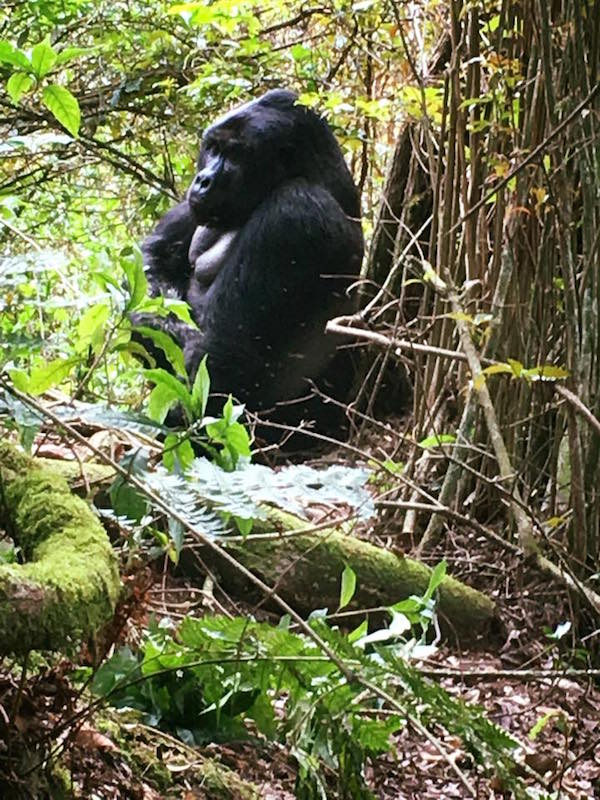It’s dark when we wake, and hard to leave our snug nest of blankets to step into the early morning chill pervading our cottage.
Peering outside we can see the mist has rolled in overnight, an eerie ghost, disguising the mountain peaks in smoke-like cloud.
We dress quickly, with nervous anticipation. We have no idea what to expect today, but our fingers are firmly crossed for a sighting of the mountain gorillas we have travelled so far to see. We know that this may be a once in a lifetime experience to see these beautiful primates in their natural habitat.
After a quick breakfast, our guide drives us to the starting point, where we are briefed about the day ahead. There are only around 880 Mountain Gorillas left in the world, with half of that number found in the Uganda and Rwanda National Park areas. The gesticulation period for a gorilla is 9 months and each mother will only birth one baby every 4 years or so, in order to breastfeed them throughout that time. Increasing their numbers therefore, is a slow process.
Conservation is a massive deal here. If you are sick, you are asked to show the true heart of conservation-and give up your place on the trek you have dreamed of and planned so carefully for. Devastating, but necessary: gorillas are susceptible to our human diseases, and it would be horribly unfair to put them at risk.
We are only permitted to spend an hour with the family, once we find them. This ensures that they get enough space from humans, without us overstepping their boundaries. They are not aggressive animals by nature, unless you threaten or agitate them, and we certainly don’t plan on doing either.
The cost of our permit (though fairly high at $600 USD each) is ploughed back into conservation and the local community. The Ranger explains that the pygmies that lived in the forest have now been displaced by the Government’s conservation policies, due to their tendency to hunt the gorillas for meat. I am torn between conflicting feelings: sadness for a culture forced out of their homes, and relief that the gorilla’s only predator is no longer a threat to them. It’s a hard contradiction for me to balance.
The track is long and winding. The hills are pretty brutal and we are each given a walking stick to make the hike more manageable. We are put into a group with others of a similar age and fitness level, because each route has different terrain and lengths, and we will hike until we find the gorillas, even if it takes us 12 hours.
The trackers are out ahead of us, communicating back to the ranger which way the gorillas are headed. It’s impressive to hear about the signs they use to understand the gorillas movements: droppings, flattened grass direction, broken branches, leftover food. Our group is flanked front and back by armed soldiers. The sight of the guns makes me feel uneasy, but the ranger assures us that the guns are only used to fire a scare shot in to the air if animals turn aggressive. There are more than just gorillas in this area, and wild animals are, of course, unpredictable.
We push on, over tree branches and through deep sucking mud. We slip and stumble all over the place, mirroring the footsteps of the person in front. The cicadas sing and their steady hum is punctuated only by birdsong and our laboured breathing. The ranger tells us to watch out for the elephant footprint ahead, which has already filled with muddy water, and would have us knee deep in muck if we stepped into it. I can’t stop staring as I pass it.
After 3 hours we are told that the gorillas are now close. It’s time to leave our backpacks behind and scramble deeper into the rainforest. The trackers go ahead, cutting through vines and branches with machetes. It’s not called the Impenetrable National Park for nothing.
There are several moments where I am massively grateful to be young and fit. As I literally haul myself up and down escarpments, with only mulch underfoot to support my weight, I wonder how many people are forced to give up at this point. A thorn in my socks distracts me, and I look down to free myself, before realising two giant safari ants are caught in the cotton and are biting me ferociously. The tracker bends and plucks them off me with his bare hands, and I smile my thanks gratefully.
The ranger halts our procession and indicates to his right with a nod of his head. I look up and time stands still. Meters away, sits the majestic silverback looking out across his domain. There is nothing between us, and if he wanted, he could reach our group in one minute flat. I am in awe of his colossal size. Muscles ripple across his dark shoulders and chest. He almost doesn’t look real. He turns his huge head and looks directly at us. Those solemn eyes look straight into my soul and I am instantly mesmerised.
He pays us no heed and we whisper and shuffle to get a better view. I snap a few pictures and remember the advice I read earlier in the trip- to just be there in the moment, watching through my own eyes, rather than the lens of a camera.
The big guy is calm. The literal translation of his African name is ‘Peace’ and in the cool dark canopy of his forest, it is easy to see why. This is his kingdom, and he permits us to pay our respects to him.
The trackers cut more branches so that we can all see properly, making gorilla grunting noises as they work, to let the silverback know that we are friends. Now and again he thrills us with a response to them. When he has had enough he hulks himself upright and ambles on massive knuckles into the undergrowth.
We sit stunned, grinning at one another. But our encounter isn’t over yet. The trackers lead us deeper into the foliage, pointing out the baby gorillas that now clamber and swing from branch to branch. We are instructed to stay as one group. If we split up and surround the family, they will think we are trying to capture them. They have long memories, and the fear of poachers is deeply ingrained.
I can’t explain the way I felt in that moment, watching them. The way their age-old faces looked intelligently back at me, wise and all-knowing. The way they played, tumbling and somersaulting for our attention. It was poetry in motion, a natural magic, and I know that my re-telling will never do the memory justice. And that’s ok. Some experiences were never meant to be bound by words or photographs anyway.
The hour passes in wonderment. I’m literally sat on the forest floor; filthy, sweaty and being feasted on by bugs, but I don’t care. I wouldn’t trade places with anyone in the world right now. As we turn to leave, one of the family clambers up into a high tree- a sentinel watching over their lands.
We wave a final goodbye, and head off, back into the mists.
Relephant:
Harambe: A Lesson on Compassion from a Tragically Deceased Gorilla.
Author: JoJo Rowden
Image: Author’s Own







Read 23 comments and reply